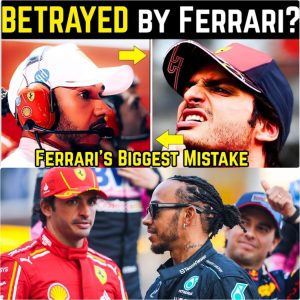In the echo chamber of online motorsport forums and clickbait headlines, a tantalizing rumor began to surface: Lewis Hamilton, after months of struggle, had finally unlocked the code. He had tamed the notoriously fickle SF-25, found the elusive balance, and was ready to fire a “warning shot” to his rivals. It’s the story every Formula 1 fan, and especially the passionate Tifosi, desperately wants to believe.
It’s a narrative of hope, of a champion’s inevitable resurgence. Unfortunately, it is a complete fiction. The stark, brutal reality, laid bare under the unforgiving summer sun at the Hungarian Grand Prix, is that Lewis Hamilton is not on the verge of a breakthrough; he is a champion lost in the wilderness.
The 2025 season was supposed to be a renaissance. Instead, it has devolved into arguably the most grueling and psychologically taxing period of Hamilton’s illustrious career.
His move to Ferrari was built on the dream of securing a record-breaking eighth world title, clad in the iconic scarlet overalls. But the dream has soured. The SF-25 has proven to be an untamable beast, a car fundamentally at odds with the sublime, smooth driving style that brought him seven world championships.

The weekend in Hungary, the final race before the mandatory F1 summer shutdown, was not a turning point. It was a breaking point. Hamilton was knocked out in the second qualifying session, a humbling experience that saw him start a lowly 12th. The race was no better; he finished where he started, a lap down, and utterly anonymous. The performance, or lack thereof, elicited some of the most startlingly raw and self-deprecating comments ever heard from the champion.
“I was absolutely useless today,” he confessed with brutal honesty after qualifying. “The team probably need to change the driver.”
This was not the calculated media-speak of a frustrated competitor. This was a cry of despair from a driver who feels completely disconnected from his machine. He spoke of “a lot going on in the background that’s not great” and admitted his mindset was “the same as yesterday” – a state of utter dejection. When asked about his plans for the summer break, his relief was palpable: “I’m glad it’s over. I’m looking forward to going away.”
These are not the words of a man who has “unlocked” his car. They are the words of a driver who has been pushed to his mental and emotional limits. Throughout the first half of the season, Hamilton has yet to score a single Grand Prix podium for Ferrari, a shocking statistic for a driver who holds the all-time record. He has been consistently outpaced by his teammate, Charles Leclerc, who, while also finding the SF-25 difficult, has managed to haul it onto the podium five times.

The core of the issue is a fundamental incompatibility. The SF-25 suffers from an unstable rear end and a front axle that doesn’t provide the sharp, confident turn-in that Hamilton’s style relies on. For over a decade at Mercedes, the cars were extensions of his will, developed and honed to suit his every input. At Ferrari, he is an outsider trying to adapt to a foreign philosophy, and the car is rejecting him at every turn.
The “warning shot” being fired is not one of impending dominance. The real warning is a desperate alarm bell being rung by Hamilton himself—a warning to the entire Maranello organization that the current path leads only to failure. His focus has already shifted dramatically from the lost cause of 2025 to the critical regulation reset of 2026. He is forcefully lobbying for his “DNA” to be embedded in the design of the next-generation car, a clear admission that the current platform is a write-off.
Furthermore, reports have emerged that Ferrari has effectively ceased major development on the SF-25 for the remainder of the season, shifting all resources to the 2026 project. This strategic decision, while sensible for the long term, leaves Hamilton stranded. He is left to see out the season in a car he detests, with no hope of significant upgrades to alleviate his struggles.
So, as the F1 world takes a collective breath during the summer break, the narrative surrounding Lewis Hamilton is not one of impending triumph. It is a story of a champion’s resilience being tested like never before. The breakthrough he needs is not in a new setup or a magical upgrade. The breakthrough must come from within himself, to endure the remainder of this painful season, and from within Maranello, to listen to their champion and build him the weapon he needs to fight for his legacy in 2026. The warning shot has been fired, but it was a cry for help, not a declaration of war.





